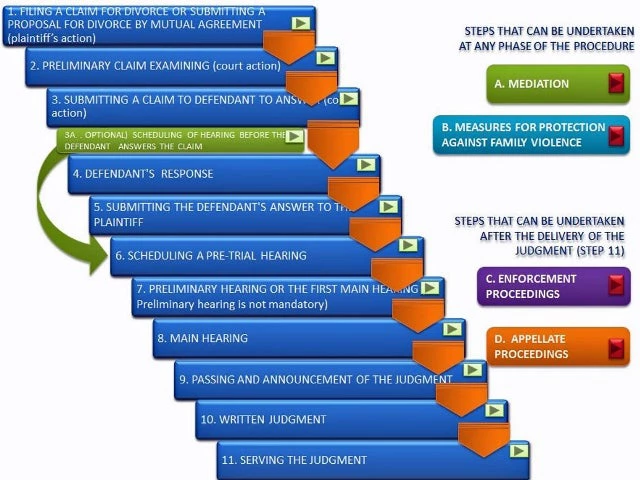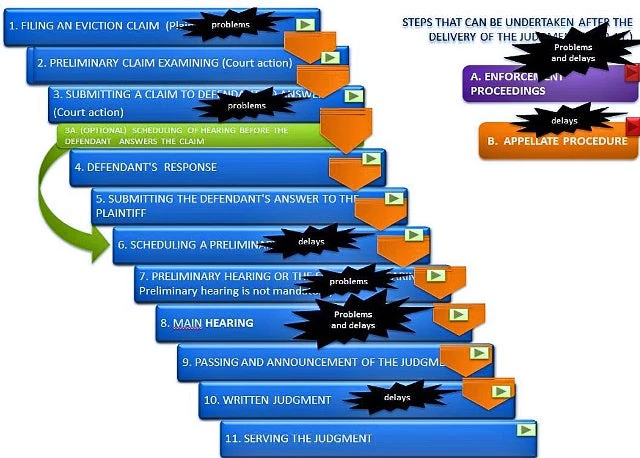Who has not faced a situation wherein the law on the books in a particular country looks just beautiful but things seem to be going horribly wrong in practice?
Such implementation gaps have haunted other development practitioners before you. It makes me curious about how Moses has felt about the implementation of the Ten Commandments.
These days, if you are the European Union, you are concerned about the implementation gap with respect to the acquis communautaire following a candidate country passing the required laws.
Whatever the gap between the law on the books and the law in practice, how does one even go about assessing it in the first place before starting to bridge it? What is feasible, given the budgets that we are likely to work with when carrying out these diagnostics?
Process maps may be just what you are looking for. As part of a Judicial Functional Review in Serbia, our team was tasked with assessing the implementation gap between the provisions in the codes and the practice in the courts. Time was limited and resources scarce.
So what did we do?
First, we picked four of the most relevant types of cases that either represented a significant portion of the courts’ caseload or had been identified by stakeholders as particularly problematic in terms of access to justice. While we understood that we needed to be selective, we were also aiming to extract more general conclusions from these specific procedures. In the end, we settled for (1) criminal cases of domestic violence; (2) divorce proceedings including the procedure for protective interim measures; (3) eviction cases; and (4) enforcement proceedings around utility bills.
Second, we prepared a map of the procedure according to the laws on the books ( de jure) for each of these types of cases. These maps show all procedural steps from beginning to end and provide the skeleton structure for the analysis. Below is the example of a de Jure map for divorce proceedings.

Third, we needed to find out about the actual practice and compare this to what the law on the books was saying in order to identify problems that may occur.
For this, we conducted in-depth interviews with professionals who deal with these specific types of proceedings on a regular basis (e.g. attorneys and bailiffs). We made sure that these practitioners covered different parts of the country and all Appellate Court districts. We knew that practice tends to vary across different places within the same country, so we wanted to capture this for a more nuanced analysis. We also wanted to be able to identify good local practice instead of having to resort to international good practice for the recommendations. So when we identified local differences, we also asked why they thought they occurred.
Interviewees were also asked to estimate how much time each procedural step takes, how much time it takes for a proceeding to reach a first instance decision, how long the entire process takes, and how much it costs. Moreover, interviewees were asked to identify the most important challenges that arise during such proceedings.
So what did we find? Well, both bright and dark spots, as the de facto map of eviction proceedings exemplifies below.

On the bright side, we did find that the judicial system in Serbia generally does not require its users to take significant steps that are not envisaged by law. However, while the steps are therefore predictable for users, key aspects – such as time and cost - are not. The analysis did identify a number of challenges for the judicial system to deliver on what reads so easily in the code.
As some of these challenges were particular to the specific procedure that was analyzed, this information can subsequently be used to address specific bottle-necks. However, many of the challenges analyzed through the process maps were cross-cutting across all court types and case types.
The dysfunctions in the service of process, required for most proceedings, serve as just one example: When the address of a defendant is unknown, it has to be obtained from the police, which is a lengthy process. Also, the police require a legal standing from those inquiring - for which they need a document issued by the court. And even when the address is known, courts – for a variety of reasons - often fail to deliver official acts properly.
At the same time, we were able to identify locations where locally driven initiatives had successfully tried to address these challenges. Such local good practice has the advantage of being more easily acceptable to stakeholders than best practice examples from other countries with potentially different legal systems and resource envelopes. The recommendations are therefore more likely to be owned locally, because they have proved to work in the Serbian context.
Our team’s conclusion on the process map analysis was that they are an excellent tool if you need data relatively quickly and at low cost. They do generate better results if the selection of case types is well informed, based on pre-existing analysis, for example, and therefore able to target meaningful procedures. It is an effective way of generating additional data, corroborating or nuancing earlier findings, and identifying local good practice. At the same time, the identification of cross-cutting bottle-necks with a significant negative impact across the board allows for prioritization of initiatives to address dysfunctions and to maximize the effect of any improvement initiative instead of just throwing more human resources at the symptoms as outlined in a previous blog.
For more information on our justice work in Serbia at http://www.mdtfjss.org.rs/en
Such implementation gaps have haunted other development practitioners before you. It makes me curious about how Moses has felt about the implementation of the Ten Commandments.
These days, if you are the European Union, you are concerned about the implementation gap with respect to the acquis communautaire following a candidate country passing the required laws.
Whatever the gap between the law on the books and the law in practice, how does one even go about assessing it in the first place before starting to bridge it? What is feasible, given the budgets that we are likely to work with when carrying out these diagnostics?
Process maps may be just what you are looking for. As part of a Judicial Functional Review in Serbia, our team was tasked with assessing the implementation gap between the provisions in the codes and the practice in the courts. Time was limited and resources scarce.
So what did we do?
First, we picked four of the most relevant types of cases that either represented a significant portion of the courts’ caseload or had been identified by stakeholders as particularly problematic in terms of access to justice. While we understood that we needed to be selective, we were also aiming to extract more general conclusions from these specific procedures. In the end, we settled for (1) criminal cases of domestic violence; (2) divorce proceedings including the procedure for protective interim measures; (3) eviction cases; and (4) enforcement proceedings around utility bills.
Second, we prepared a map of the procedure according to the laws on the books ( de jure) for each of these types of cases. These maps show all procedural steps from beginning to end and provide the skeleton structure for the analysis. Below is the example of a de Jure map for divorce proceedings.

Third, we needed to find out about the actual practice and compare this to what the law on the books was saying in order to identify problems that may occur.
For this, we conducted in-depth interviews with professionals who deal with these specific types of proceedings on a regular basis (e.g. attorneys and bailiffs). We made sure that these practitioners covered different parts of the country and all Appellate Court districts. We knew that practice tends to vary across different places within the same country, so we wanted to capture this for a more nuanced analysis. We also wanted to be able to identify good local practice instead of having to resort to international good practice for the recommendations. So when we identified local differences, we also asked why they thought they occurred.
Interviewees were also asked to estimate how much time each procedural step takes, how much time it takes for a proceeding to reach a first instance decision, how long the entire process takes, and how much it costs. Moreover, interviewees were asked to identify the most important challenges that arise during such proceedings.
So what did we find? Well, both bright and dark spots, as the de facto map of eviction proceedings exemplifies below.

On the bright side, we did find that the judicial system in Serbia generally does not require its users to take significant steps that are not envisaged by law. However, while the steps are therefore predictable for users, key aspects – such as time and cost - are not. The analysis did identify a number of challenges for the judicial system to deliver on what reads so easily in the code.
As some of these challenges were particular to the specific procedure that was analyzed, this information can subsequently be used to address specific bottle-necks. However, many of the challenges analyzed through the process maps were cross-cutting across all court types and case types.
The dysfunctions in the service of process, required for most proceedings, serve as just one example: When the address of a defendant is unknown, it has to be obtained from the police, which is a lengthy process. Also, the police require a legal standing from those inquiring - for which they need a document issued by the court. And even when the address is known, courts – for a variety of reasons - often fail to deliver official acts properly.
At the same time, we were able to identify locations where locally driven initiatives had successfully tried to address these challenges. Such local good practice has the advantage of being more easily acceptable to stakeholders than best practice examples from other countries with potentially different legal systems and resource envelopes. The recommendations are therefore more likely to be owned locally, because they have proved to work in the Serbian context.
Our team’s conclusion on the process map analysis was that they are an excellent tool if you need data relatively quickly and at low cost. They do generate better results if the selection of case types is well informed, based on pre-existing analysis, for example, and therefore able to target meaningful procedures. It is an effective way of generating additional data, corroborating or nuancing earlier findings, and identifying local good practice. At the same time, the identification of cross-cutting bottle-necks with a significant negative impact across the board allows for prioritization of initiatives to address dysfunctions and to maximize the effect of any improvement initiative instead of just throwing more human resources at the symptoms as outlined in a previous blog.
For more information on our justice work in Serbia at http://www.mdtfjss.org.rs/en


Join the Conversation